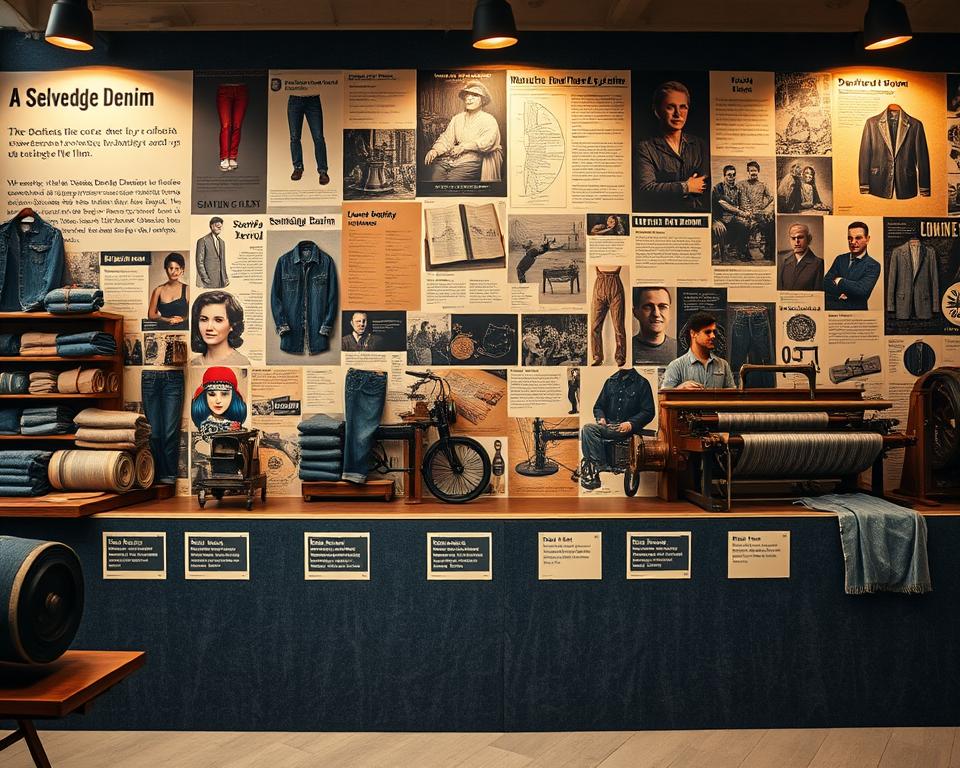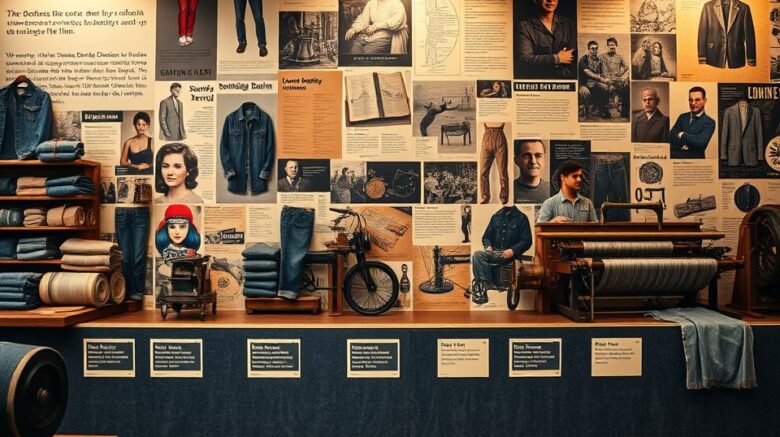The Ultimate Guide to Superior denim Selvedge Material
Ever pondered why some jeans seem like they’re designed for longevity a lifetime? Everything revolves around the elements and artistry. Take, for instance, the increasing movement of high-end selvedge. This isn’t just any textile—it attests to excellence and legacy.
Nowadays, more people are choosing these timeless textiles for their durability and traditional ewingfly denim allure. Be it that you are a home sewing sewist or a denim enthusiast, there’s a unique quality about using superior cotton and stitching. It goes beyond merely making pants; it centers on producing something that tells a story.
Here at Core Fabrics, we’ve curated a selection of 14.25oz eco-friendly cotton and elastic variants. These materials are perfect for all from raw trousers to designer jacket patterns. Prepared to dive into the world of top-tier fabrics? Let’s jump right in.
What Is Denim Selvedge Fabric?
Why do particular jeans distinguish themselves with their signature, naturally edged seams? The secret lies in the selvedge denim, a superior material celebrated for its durability and vintage appeal. In contrast to regular textiles, this type of fabric is crafted using classic methods that have proven their worth.
Understanding Selvedge Denim
Selvedge denim is manufactured via old-style shuttle looms, which produce narrow widths of about 30-35 inches. They intertwine the textile in a method that delivers self-finished borders, often marked by a distinctive red line. This method confirms the textile is densely interlaced and exceptionally sturdy.
Modern looms, alternatively, produce expansive material but do not offer the equivalent of skill. Minor flaws in selvedge, like misaligned seams or inconsistent patterns, are accepted as part of its charm. This philosophy, known as “wabi-sabi”, exalts the aesthetic of organic flaws.
Production of Selvedge Denim
The manufacturing of selvedge denim involves a exacting process. Traditional shuttle looms cross the horizontal threads alternately, resulting in a dense and resilient textile. Unlike modern methods with new-age looms, which focus on quick production and efficiency over durability.
Brands like Karson Denim maintain vintage Japanese weaving techniques from the nineteen-nineties. They intentionally include flaws to retain the true character of the fabric. All products is graded on a 4-point system, guaranteeing it fulfills the peak requirements of superiority.
| Characteristic | Selvedge Denim | Current Denim |
|---|---|---|
| Span | 30-35 inches | 60+ inches |
| Weaving Process | Traditional Shuttle | Contemporary Loom |
| Surface | Non-uniform, Raw | Consistent |
| Sturdiness | Exceptional | Standard |
“The charm of selvedge lies in its imperfections—each irregularity speaks of skill and legacy.”
The History of Selvedge Denim
From humble beginnings to international fame, the narrative of these textiles is vibrant and inspiring. Initially designed as rugged attire in seventeenth-century France evolved into a symbol of timeless style and excellence.
Beginnings in Craftsmanship
The origin of this material reaches back to Nîmes, France, where it was known as “serge de Nîmes.” Initially created for laborers, it was made from hardwearing cotton and thread. Its resilience made it a favorite among the workforce during the era of the Gold Rush.
By the 20th century, it had transformed into a staple for pants. The shuttering of the Cone Mills White Oak facility became a pivotal moment. This transition opened the door for Japanese craftsmen to reintroduce old-world weaving methods.

Evolution in Modern Denim Production
Post-WWII, Japan developed a deep appreciation for vintage American culture. Skilled workers revitalized old looms to create genuine reproductions. This devotion to craftsmanship secured the continuance of selvedge as a niche product.
In modern times, advancements from Italy and Turkey have introduced environmentally conscious combinations and elastic variants. These modernizations have enhanced the appeal of this timeless fabric. At Core Fabrics, we procure internationally, from Montréal to Asia, to deliver to you the finest quality.
“The legacy of selvedge is a testament to the enduring value of excellence and heritage.”
The Benefits of Selvedge Denim?
What makes selvedge denim stand out in the realm of premium textiles? Its unique qualities and incomparable robustness render it popular among lovers and creatives alike. Be it that you are crafting jeans or a tailored jacket, this textile offers a fusion of heritage and updated style.
Distinctive Attributes of Selvedge
Selvedge denim is celebrated for its firm interlacing, which boosts tear resistance and color fading characteristics. In contrast to common fabrics, rainbow selvedge denim is crafted using traditional shuttle looms, creating a more compact and extra robust product. Such a process guarantees that every item possesses a distinct surface and personality.
Notable attributes are:
- Hairy, rigid raw denim offers a contrast to pre-washed comfort stretches.
- Sanforization stabilizes the fabric for consistent measurements, while raw options offer a unique shrinkage journey.
- Weight options range from 9.5oz Eco Finish to 14.25oz Organic, catering to different needs.
Sturdiness and Lifespan
One of the key attributes of selvedge denim is its long life. The dense fabric structure not only increases durability but also allows for characteristic wear patterns over time. This establishes it as a valuable investment for those looking for enduring style.
Important aspects:
- Fabrics weighing between 12oz and 14oz are perfect for form-fitting jackets and jeans that mellow with time.
- For classic jean longevity, the 14.25oz True Indigo is a top recommendation.
- Eco-friendly options, like recycled cotton and indigo blends, add sustainability to your wardrobe.
Within our range at Core Fabrics, diverse choices cater to distinct demands. From raw to sanforized, each piece is crafted to deliver exceptional quality and value.
Selvedge vs. Wide Denim: A Comparison
In the creation of robust and fashionable apparel, the selection of fabric plays a crucial role. Two popular options are selvedge and wide denim, each with unique characteristics. Understanding their differences can help you choose the best option for your endeavor.
Contrasting Weave Techniques
Selvedge denim is woven on traditional shuttle looms, producing limited spans of 30-35 inches. This striped selvedge denim fabric method forms firm borders, often accented with a distinctive red line. Conversely, wide denim employs advanced projectile looms, yielding widths of 60 inches or more.
Traditional shuttle looms operate at approximately 3 meters per minute, while contemporary projectile looms achieve up to 30m per minute. Such speed differences influence both the expense and the surface quality of the final product.
Benefits and Drawbacks
Selvedge denim is renowned for its high-end construction and robustness. Its limited breadth makes it ideal for creations where defined edges and detail work are sought. However, it can be costlier, averaging $23 per meter.
Wide denim is budget-friendly, typically costing $8 per half-meter. Its expansive dimension reduces waste, well-suited to big-scale works like upholstery. However, it lacks the distinctive selvage detail of selvedge.
| Feature | Selvedge Denim | Wide Denim |
|---|---|---|
| Span | 30-35 inches | 60+ inches |
| Method | Classic Shuttle Loom | Projectile Loom |
| Rate | 3 meters per minute | 30m per minute |
| Cost | $23/meter | $8/half-meter |
For defined borders as seen in Grainline Thayer jackets, selvedge is favored. Conversely, wide denim is ideal for extensive projects due to its efficiency. Weigh your requirements carefully to decide.
How to Use Selvedge Denim
Crafting with high-end textiles raises your projects to a new standard. Whether you are creating trousers, blazers, or dresses, grasping fabric quantities, proper sewing methods, and maintenance guarantees a polished result. Let’s delve into ways to best utilize this timeless textile.
Material Requirements for Jeans and Jackets
It is essential to compute the correct fabric amount when designing your creation. Approximately 3-3.3 yards is necessary for men’s jeans, considering defects and shrinkage. For trucker jackets, expect to use around 3.3 yards, while a skirt often needs 2 yards.
Creative pattern placement can help manage imperfections in the material. Embrace the natural defects by weaving them into your creative design.
| Garment | Required Yardage |
|---|---|
| Jeans for Men | 3 to 3.3 yards |
| Trucker-Style Jacket | 3.3 yards |
| Skirt | 2 yards |
Tips for Sewing and Care
Using the right tools and techniques ensures a polished result. Select #70 to 110 pins and foot accessories made for robust textiles. For contrast stitching, Gütermann rPET thread is a reliable choice.
Consider these extra tips:
- A tailor’s clapper helps deliver defined creases without unwanted shine.
- Our denim kits from Core Fabrics comprise topstitch thread, rivets, and 9mm jeans buttons to ensure a refined result.
- When sturdy borders are needed, such as in jackets, selvedge is optimal.
Maintaining your pieces properly increases their longevity. Use minimal washing and opt for air drying to preserve fabric quality. Adhering to these practices will sustain your creations for years.
Conclusion
Working with high-end textiles is not solely about longevity; it’s about infusing character. Selvedge denim epitomizes this ideology, fusing handcrafted appeal with enduring excellence. From jeans to tailored jackets, every stitch of this material conveys a narrative.
At Core Fabrics, we make it easy to explore your creativity. Try our swatch service to feel the texture and weight before committing. Furthermore, take advantage of free shipping for orders above $150 USD in North America.
Looking ahead, eco-friendly blends and vintage washes are shaping the future of cotton textiles. These trends offer new ways to add sustainability and style to your wardrobe.
Eager to explore top-tier textiles? Shop now and discover the value of crafting with purpose. Your subsequent creation may well become an enduring classic.
